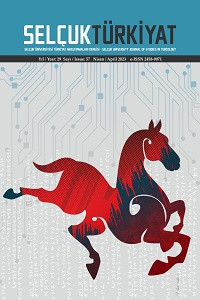Öz
Bu çalışma, lise öğrencilerinin zihinlerinde Osmanlı Türkçesi ve dersiyle ilgili oluşmuş kanaat, ilgi ve görüşlerini belirleyip dersi alan ve almayan öğrenciler üzerinden bir karşılaştırma yaparak öğrencilerin dersle ilgili görüşlerini belirlemek amacıyla yapılmıştır. Çalışmada nitel araştırma yöntemlerinde olgubilim ve durum çalışması desenleri kullanılmıştır. Veriler toplam 76 lise öğrencisinin katılımıyla toplanmıştır. Verilerin toplanmasında veri toplama yöntemi olarak görüşme, verilerin çözümlenmesinde ise içerik analizi yöntemi kullanılmıştır. Veri toplama aracı olarak ise açık uçlu araştırma sorularıyla hazırlanan yapılandırılmış görüşme formundan faydalanılmıştır. Çalışmada lise öğrencilerinin Osmanlı Türkçesi ve dersiyle ilgili hazırladığımız sorulara verdikleri cevaplar kodlanarak temalara ayrılmış ve bu temalara göre frekans değerleri verilmiştir. Araştırmadan elde edilen veriler toplam 133 tema altında toplanmıştır. Belirlenen temalardan hareketle katılımcıların Osmanlı Türkçesi dersine dair görüş ve düşüncelerine yer verilmiştir. Çalışma grupları arasında yapılan karşılaştırmaya göre aksini belirten öğrenciler olsa da öğrenciler tarafından genel olarak en fazla değinilen durum, “Osmanlı Türkçesi öğrenerek geçmişi öğrenmek, geçmiş ve gelecek arasında bağ kurmak, geçmişten kalan eserleri okuyabilmek” şeklinde olmuştur.
Anahtar Kelimeler
Osmanlı Türkçesi Osmanlı Türkçesi dersi görüş nitel araştırma yöntemi görüşme.
Öz
This study was carried out to determine the opinions, interests and views formed in the minds of high school students about Ottoman Turkish and the Ottoman Turkish lesson, and to determine the opinions of the students about the lesson by making a comparison between the students who took the lesson and those who did not. Phenomenology and case study patterns were used as a qualitative research method in the study. Data were collected with the participation of a total of 76 high school students. Interview method was used for data collection and content analysis method was used for data analysis. As a data collection tool, a structured interview form prepared with open-ended research questions was used. In the study, the answers given by high school students to the questions we prepared about Ottoman Turkish, and its course were coded and separated into themes and frequency values were given according to these themes. The data obtained from the research were collected under a total of 133 themes. Based on the determined themes, the opinions, and thoughts of the participants about the Ottoman Turkish lesson were included. According to the comparison made between the study groups, although there were students who stated the opposite, the most frequently mentioned situation by the students was "learning the past by learning Ottoman Turkish, establishing a connection between the past and the future, being able to read works from the past".
Anahtar Kelimeler
Ottoman Turkish Ottoman Turkish course opinion qualitative research method interview.
Ayrıntılar
| Birincil Dil | Türkçe |
|---|---|
| Konular | Sanat ve Edebiyat |
| Bölüm | Araştırma Makalesi |
| Yazarlar | |
| Erken Görünüm Tarihi | 27 Nisan 2023 |
| Yayımlanma Tarihi | 18 Nisan 2023 |
| Yayımlandığı Sayı | Yıl 2023 Sayı: 57 |
Selçuk Üniversitesi Türkiyat Araştırmaları Dergisi Creative Commons Atıf-GayriTicari 4.0 Uluslararası Lisansı (CC BY NC) ile lisanslanmıştır.


